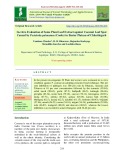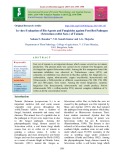
Food poisoning
-
In the present investigation 30 Plant leaf extract were evaluated in in vitro condition against P. palmarum adopting poisoned food technique. The per cent inhibition of pathogen was 100 per cent by Dhatura, Anjwain and Tobacco at 10 per cent concentration followed by the turmeric (95.84), safed musli (90.62), garlic (87.5), hathjodh (86.5), kalmegh (86.46), jetropha (83.34), neem bark (79.18), satavar (78.12), lemongrass (69.81), laung (67.71), ashoka (65.62), aadusa (63.68), karanj bark (63.06), bhringraj (62.5), karanj (62.5), dalchini (61.15), beshram (60.43), brijdanti (57.
 7p
7p  angicungduoc6
angicungduoc6
 22-07-2020
22-07-2020
 23
23
 2
2
 Download
Download
-
Foot rot of tomato is an important disease which causes severe loss in tomato production. The present study was carried out to evaluate five bioagents and six fungicides against Sclerotium rolfsii. Among the five antagonists tested the maximum inhibition was observed in Trichoderma virens (67%) and contrarily, no inhibition was observed in Bacillus subtilis. Six fungicides viz., carbendazim, captan, tebuconozole, copper oxychloride, hexaconozole and Tebuconazole +Trifloxytrobin at different concentrations (50, 100, 150, 200, 250 and 500 ppm), were tested.
 8p
8p  chauchaungayxua6
chauchaungayxua6
 26-06-2020
26-06-2020
 20
20
 4
4
 Download
Download
-
Vibrio mimicusis a causative agent of human gastroenteritis and food poisoning, and this species produces an enterotoxic hemolysin (V. mimi-cus hemolysin) as a virulence determinant. Vibrio mimicushemolysin is secreted as an 80 kDa precursor, which is later converted to the 66 kDa mature toxin through removal of an N-terminal propeptide via cleavage of the Arg151–Ser152 bond.
 10p
10p  vinaphone15
vinaphone15
 27-02-2013
27-02-2013
 37
37
 4
4
 Download
Download
-
Water used in slaughtering operations are considered one source of infected carcass during slaughter, particularly in the private slaughterhouses. The purpose of this study was to identify some species of microorganisms causing food poisoning from the water samples used in the slaughter ...
 8p
8p  thulanh2
thulanh2
 07-09-2011
07-09-2011
 61
61
 9
9
 Download
Download
-
NGỘ ĐỘC THỨC ĂN (FOOD POISONING) Phần 2 18/ VI KHUẨN GÂY TIÊU CHẢY NÀO LIÊN KẾT VỚI CO GIẬT DO SỐT Ở TRẺ EM ? Nhiễm trùng Shigella nơi các trẻ nhỏ thường gây nên sốt cao với các cơn co giật do sốt (febrile seizures) trước khi khởi đầu bệnh tiêu chảy. Bệnh có thể rất nặng và tử vong do mất nước (dehydration) có thể xảy ra trong vòng 8 giờ kể từ khi bắt đầu tiêu chảy. Đau bụng và sốt thường đi trước tiêu chảy. Trong trường hợp điển hình, phân có máu và có dạng...
 13p
13p  sinhtobo111
sinhtobo111
 13-04-2011
13-04-2011
 84
84
 8
8
 Download
Download
-
NGỘ ĐỘC THỨC ĂN (FOOD POISONING) Phần 1 1/ KỂ NHỮNG NGUYÊN NHÂN CỦA NGỘ ĐỘC THỨC ĂN - Ngoại độc tố được sản xuất bởi vi sinh vật - Các vi sinh vật ( vi khuẩn, nấm, virus, ký sinh trùng) (được xếp loại thành xâm nhập ( invasive ), không xâm nhập ( noninvasive ) hoặc sinh độc tố ( toxin-producing) - Các chất hiện diện trong thức ăn một cách tự nhiên ( amatoxin (nấm), dinoflagellates hay thallophytes) 2/ MỨC ĐỘ LƯU HÀNH CỦA NGỘ ĐỘC THỨC ĂN? CÓ GÂY CHẾT NGƯỜI KHÔNG? Từ năm 1996 đến 1997, người...
 12p
12p  sinhtobo111
sinhtobo111
 13-04-2011
13-04-2011
 78
78
 10
10
 Download
Download
CHỦ ĐỀ BẠN MUỐN TÌM


















